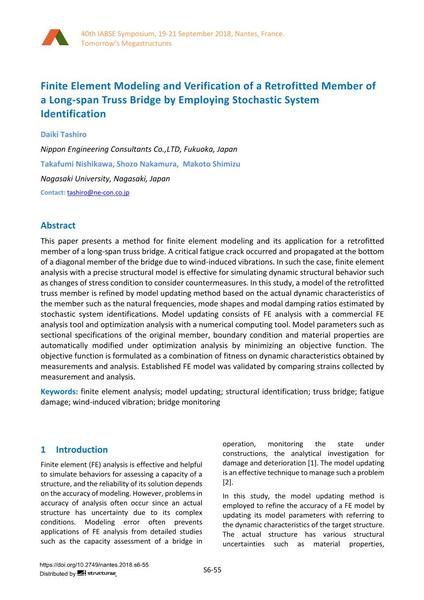Finite Element Modeling and Verification of a Retrofitted Member of a Long-span Truss Bridge by Employing Stochastic System Identification

|
|
|||||||||||
Bibliographic Details
| Author(s): |
Daiki Tashiro
(Nippon Engineering Consultants Co.,LTD, Fukuoka, Japan Takafumi Nishikawa, Shozo Nakamura, Makoto Shimizu Nagasaki University, Nagasaki, Japan)
Takafumi Nishikawa (Nippon Engineering Consultants Co.,LTD, Fukuoka, Japan Takafumi Nishikawa, Shozo Nakamura, Makoto Shimizu Nagasaki University, Nagasaki, Japan) Shozo Nakamura (Nippon Engineering Consultants Co.,LTD, Fukuoka, Japan Takafumi Nishikawa, Shozo Nakamura, Makoto Shimizu Nagasaki University, Nagasaki, Japan) Makoto Shimizu (Nippon Engineering Consultants Co.,LTD, Fukuoka, Japan Takafumi Nishikawa, Shozo Nakamura, Makoto Shimizu Nagasaki University, Nagasaki, Japan) |
||||
|---|---|---|---|---|---|
| Medium: | conference paper | ||||
| Language(s): | English | ||||
| Conference: | IABSE Symposium: Tomorrow’s Megastructures, Nantes, France, 19-21 September 2018 | ||||
| Published in: | IABSE Symposium Nantes 2018 | ||||
|
|||||
| Page(s): | S6-55 | ||||
| Total no. of pages: | 8 | ||||
| DOI: | 10.2749/nantes.2018.s6-55 | ||||
| Abstract: |
This paper presents a method for finite element modeling and its application for a retrofitted member of a long-span truss bridge. A critical fatigue crack occurred and propagated at the bottom of a diagonal member of the bridge due to wind-induced vibrations. In such the case, finite element analysis with a precise structural model is effective for simulating dynamic structural behavior such as changes of stress condition to consider countermeasures. In this study, a model of the retrofitted truss member is refined by model updating method based on the actual dynamic characteristics of the member such as the natural frequencies, mode shapes and modal damping ratios estimated by stochastic system identifications. Model updating consists of FE analysis with a commercial FE analysis tool and optimization analysis with a numerical computing tool. Model parameters such as sectional specifications of the original member, boundary condition and material properties are automatically modified under optimization analysis by minimizing an objective function. The objective function is formulated as a combination of fitness on dynamic characteristics obtained by measurements and analysis. Established FE model was validated by comparing strains collected by measurement and analysis. |
||||
| Keywords: |
fatigue damage finite element analysis FEA truss bridge wind-induced vibration bridge monitoring structural identification model updating
|
||||
